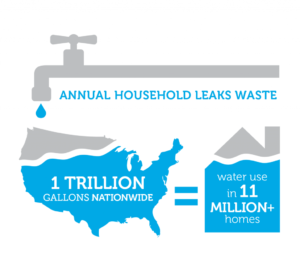How much money are your leaky faucets and toilets costing you? And how much water are they wasting?
I asked Karen Wirth, the education and outreach coordinator for EPA’s WaterSense program, why we should bother to fix leaky faucets when it can be such a pain, and expensive, too, if you need to call a plumber. Here’s what she had to say (and I think it’s pretty convincing):
You might be able put up with the occasional drip-drip-drip after you turn off the water from your morning shower. Or think nothing of having to jiggle the handle after you flush to quiet your old toilet.
But these easy-to-fix leaks could be wasting more than 10,000 gallons of water each year—what you use to wash 270 loads of laundry—and worse yet, adding 10 percent to your water bill.
Maybe you’re intimidated by the thought of tackling leaks at home, or think it will be expensive. But in many cases, repairs don’t require a major investment or a plumbing license.
Take toilets, for example. Leaks are usually easy to hear. You can also identify silent leaks by putting a few drops of food coloring in the tank at the back of your toilet. Wait 10 minutes. If color appears in the bowl, you have a leak. (Make sure you flush afterward to avoid staining!)

But if you take into account the fact that a running toilet can waste as much as 21,600 gallons of water per month and cost your family more than $2,000 extra in annual water charges, that’s a small time and money investment for the payback. Consider using the Green Plumbers® locator to find a professional who has completed accreditation training in environmental issues and water-efficient technology.
EPA’s Fix a Leak Week

1. Check. Start your leak check by looking at your January or February water bill. If your winter monthly use was higher than 12,000 gallons for a family of four, you probably have a serious leak. You can also check your water meter (it’s usually outside the house) before and after a two-hour period when no water is being used. If the reading has changed, something’s leaking.
2. Twist. Over the course of a year, a faucet that’s leaking just one drip per second can waste the amount of water needed to take more than 180 showers! Twist and tighten pipe connections with a wrench, or use pipe tape to seal where showerheads are shedding. To save even more water without a noticeable difference in flow, twist on a WaterSense labeled faucet aerator in your bathroom.
3. Replace. If you can’t fix the leaks with your own DIY skills, it might be time to replace the fixture. Look for the WaterSense label (above left) associated with toilets, showerheads, and bathroom sink faucets and accessories that are independently certified to use at least 20 percent less water and perform as well as or better than standard models. That means you won’t waste time double-flushing or waiting for a weak spray to wash your hair.
Need more inspiration? Visit the WaterSense website to learn more about how to find and fix leaks or watch this simple animated short video. And if you do take the plunge and repair a leaky fixture, tweet a photo with #IFixLeaks to show your skills at saving water and money!
Karen Wirth is EPA’s WaterSense education and outreach coordinator. She has worked in a variety of program areas at EPA, focusing for the past 17 years on water issues.
RELATED POSTS:
Are You Taking A WaterSense Shower?
Ten Ways to Save Water Outside and Cut Your Water Bill by 50%
My New Water-Saving Toilet


















4 thoughts on “Find & Fix Leaky Faucets & Toilets Before Drips Drain Your Wallet”
A leaky faucet can create many problems at home.
A leaky faucet can create many problems at home. The first thing you should do to start repairing a leaky faucet to stop the water supply to the faucet.
To do this, you must carefully unscrew and remove every knob on the faucet and then carefully replace the washer. Remember to tighten all the screws very well to prevent further leakages. If you found this job difficult then you can call up commercial sewer repair NJ services.
Good suggestions (and very sneaky the way you suggested NJ repair services!). Thanks!!
Comments are closed.